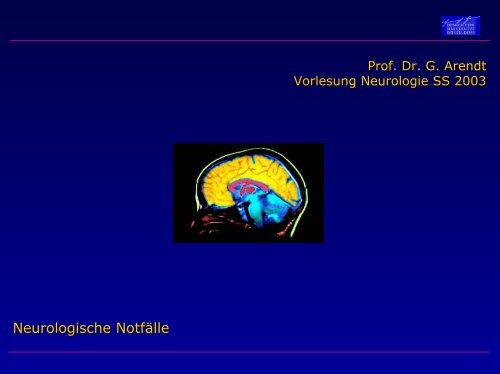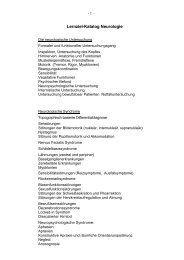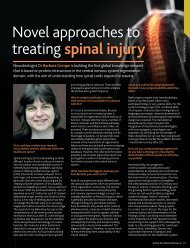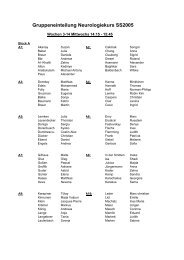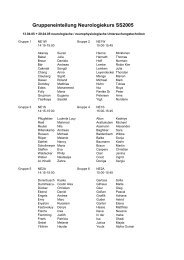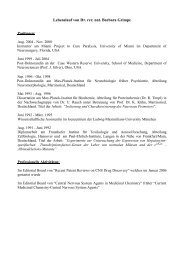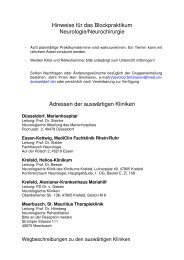Neurologische Notfälle - Neurologische Klinik
Neurologische Notfälle - Neurologische Klinik
Neurologische Notfälle - Neurologische Klinik
Sie wollen auch ein ePaper? Erhöhen Sie die Reichweite Ihrer Titel.
YUMPU macht aus Druck-PDFs automatisch weboptimierte ePaper, die Google liebt.
Prof. Dr. G. Arendt<br />
Vorlesung Neurologie SS 2003<br />
<strong>Neurologische</strong> Notfälle
Vorlesung Prof. Dr. Arendt SS 2003<br />
<strong>Neurologische</strong> Notfälle<br />
I. Koma<br />
II.<br />
III.<br />
IV.<br />
Status epilepticus<br />
„akutes Psychosyndrom“<br />
Querschnitt<br />
V. Guillain-Barré<br />
Barré-Syndrom<br />
VI.<br />
Myasthene Krise
Vorlesung Prof. Dr. Arendt SS 2003<br />
Komaursachen auf neurologischem Fachgebiet<br />
1. Subarachnoidale/intracerebrale Blutung<br />
2. Tumor mit „Einklemmungssymptomatik“<br />
3. Vaskuläre Ursachen<br />
a) raumfordernder Insult<br />
b) Hirnvenenthrombose<br />
c) Sinusvenenthrombose<br />
4. Intoxikation
Vorlesung Prof. Dr. Arendt SS 2003<br />
Augensymptome des Bewusstlosen<br />
mäßige Miosis (2-3 mm ∅)<br />
Läsion subthalamisch<br />
starke Miosis (7-10 mm ∅)<br />
Subtotale Mittelhirnschädigung<br />
mäßige Mydriasis (4-6 mm ∅)<br />
und schlechte Lichtreaktion<br />
Schwere Mittelhirnschädigung<br />
starke bilaterale Miosis (1 mm ∅)<br />
Läsionen der Brückenhaube
Vorlesung Prof. Dr. Arendt SS 2003<br />
Subarachnoidale/intracerebrale Blutung<br />
Symptomatik:<br />
„Vernichtungskopfschmerz“<br />
Vegetative Symptome:<br />
Erbrechen, Schweißausbruch, Blutdruckschwankungen, irreguläre<br />
Atmung, Meningismus, Pupillendifferenz (eine Seite lichtstarr bzw.<br />
träge reagierend), fokal-neurologische Defizite entsprechend der<br />
Lokalisation<br />
Diagnostik:<br />
cMRT (bei i.c. Blutung), falls nicht verfügbar, CCT<br />
a) bei SAB ⇒ cerebrale Angiographie (DSA)<br />
b) bei monolokulärer i.c. Blutung keine weitere<br />
Akutdiagnostik<br />
Procedere:<br />
a) bei Aneurysmanachweis ⇒ OP<br />
b) bei monolokulärer i.c. Blutung ⇒ Zuwarten
Bildgebung<br />
Vorlesung Prof. Dr. Arendt SS 2003
Vorlesung Prof. Dr. Arendt SS 2003<br />
Tumor mit „Einklemmung“<br />
Symptomatik:<br />
bei meist mehrmonatiger Kopfschmerzanamnese<br />
Schmerzzunahme über wenige Tage bis Stunden,<br />
Nüchternerbrechen, dann rasch einsetzende<br />
Bewusstseinstrübung, Stauungspapille,<br />
Pupillendifferenz (eine Seite lichtstarr respektive<br />
mit träger Lichtreaktion)<br />
Diagnostik:<br />
cMRT + Gadolinium<br />
Procedere:<br />
Shunt
Vorlesung Prof. Dr. Arendt SS 2003<br />
Vaskuläre Hirndruckursachen I<br />
1. Raumfordernder Insult<br />
Symptomatik:<br />
A. cerebri media<br />
fokal neurologische Defizite<br />
A. basilaris<br />
- Bewusstseinstrübung, Pupillendifferenz<br />
Diagnostik:<br />
cMRT, MR-A, DWI, PWI<br />
Procedere:<br />
bei Eintreffen des Patienten im sog. „Drei-Stunden-<br />
Fenster“ – Lyse<br />
bei gravierender Raumforderung mit<br />
„Einklemmungsgefahr“ – neurochirurgische<br />
Intervention
Vorlesung Prof. Dr. Arendt SS 2003<br />
Vaskuläre Hirndruckursachen II<br />
2. Hirnvenenthrombose<br />
Symptomatik:<br />
Hirndrucksymptomatik, meist keine fokalneurologischen<br />
Defizite<br />
Diagnostik:<br />
cMRT + MR-Angiographie<br />
Procedere:<br />
Heparin, Osmofundin
Vorlesung Prof. Dr. Arendt SS 2003<br />
Vaskuläre Hirndruckursachen III<br />
3. Sinusvenenthrombose<br />
Symptomatik:<br />
Serie von Grand-Mal-Anfällen, protrahierte<br />
Bewusstseinstrübung, Hirndrucksymptome, ggf.<br />
fokal-neurologische Defizite<br />
Diagnostik:<br />
cMRT + KM (plurilokuläre, intracerebrale Blutung,<br />
„empty triangle“, Hirnödem), MR-A, ggf. DSA – falls<br />
Kernspintechnik nicht verfügbar, CCT + KM<br />
Procedere:<br />
Vollheparinisierung, antiödematöse Therapie
Angiographie<br />
Vorlesung Prof. Dr. Arendt SS 2003
Vorlesung Prof. Dr. Arendt SS 2003<br />
Intoxikation<br />
Symptomatik:<br />
Diagnostik:<br />
- Foetor (!)<br />
- Pupillenweite und -reaktion<br />
- Hautfarbe (!)<br />
-Schwitzen<br />
- ∅ Meningitis<br />
- ∅ fokal-neurologischen Defizite<br />
- Verwirrtheit, psychomotorische Unruhe<br />
Analyse von Blut, Urin und Magensaft<br />
Procedere:<br />
multidisziplinäre Betreuung( Internist, Neurologe,<br />
Psychiater)
Vorlesung Prof. Dr. Arendt SS 2003<br />
Durchgangssyndrom<br />
Symptomatik:<br />
Diagnostik:<br />
Procedere:<br />
- erhaltenes Bewusstsein (!)<br />
- psychomotorische Unruhe<br />
- Verwirrtheit<br />
- Desorientiertheit<br />
- Fremdanamnese (falls verfügbar)<br />
- körperliche Untersuchung (falls möglich)<br />
- Fieber messen<br />
- Blut- und Urinanalysen<br />
erst danach:<br />
- Sedierung<br />
- apparative Diagnostik
Vorlesung Prof. Dr. Arendt SS 2003<br />
Häufigste Ursachen eines Durchgangssyndrom<br />
Patienten < 65 Jahre<br />
- Intoxikation und Alkoholentzug<br />
- Psychose<br />
- postiktaler Dämmerzustand<br />
- Schädel-Hirn-Trauma<br />
- intracerebrale Blutung<br />
- Meningoencephalitis<br />
Patienten > 65 Jahre<br />
- cerebro-vaskuläre Insuffizienz<br />
- Schädel-Hirn-Trauma<br />
- intracerebrale Blutung<br />
- Meningoencephalitis
Vorlesung Prof. Dr. Arendt SS 2003<br />
Status epilepticus<br />
Symptomatik:<br />
Häufigkeit:<br />
Procedere:<br />
Der Patient erlangt zwischen den Grand-mal-<br />
Anfällen das Bewusstsein nicht wieder<br />
3-8 % aller Anfallskranken<br />
- bei genuiner Epilepsie häufigste Ursache:<br />
plötzliches Absinken des Medikamentenspiegels<br />
- bei symptomatischer Epilepsie häufigste<br />
Ursache: Stirnhirntumor<br />
Lorazepam<br />
Phenytoin<br />
Barbiturat<br />
Chlomethiazol<br />
antiödematöse Therapie
Vorlesung Prof. Dr. Arendt SS 2003<br />
Querschnitt<br />
= medizinischer Notfall bei Symptombeginn 6-8h 6<br />
vor Hospitalisierung<br />
Symptomatik:<br />
Ursachen:<br />
Procedere:<br />
A. „hoher Querschnitt“<br />
Motorische Ausfälle aller Extremitäten, sensible<br />
Ausfälle aller Qualitäten unterhalb der Läsion<br />
Cave: Zwerchfellparese<br />
B. Conus-Cauda-Syndrom<br />
Motorische Defizite der unteren Extremitäten<br />
Sensible Ausfälle i. S. der Reithosenanästhesie<br />
Cave: Blasen- u. Mastdarmfunktionsstörungen<br />
- Tumoren<br />
- Bandscheibenvorfälle<br />
- vaskuläre Prozesse<br />
Spinales MRT, ggf.<br />
Myelographie ⇒ OP
Vorlesung Prof. Dr. Arendt SS 2003<br />
Pontine Myelinolyse<br />
Ursache:<br />
<strong>Klinik</strong>:<br />
wahrscheinlich zu rascher Ausgleich einer<br />
Hyponatriämie<br />
- Tetraparese bis Tetraplegie<br />
- „locked-in“<br />
Diagnostik:<br />
cMRT<br />
Differentialdiagnosen:<br />
- Basilaristhrombose<br />
- akutes Wernicke Syndrom
Vorlesung Prof. Dr. Arendt SS 2003<br />
Myasthene Krise<br />
Symptomatik:<br />
- Tetraparese bis –plegie<br />
- erhaltenes Bewusstsein<br />
- Sprach- und Schluckstörungen<br />
- Atemlähmung<br />
Diagnostik:<br />
- pharmakologischer Test (Prostigmin, Tensilon)<br />
- Acetylcholin-Rezeptor-Antikörper-Bestimmung<br />
Procedere:<br />
Prostigminperfusor<br />
Plasmaseparation
Vorlesung Prof. Dr. Arendt SS 2003<br />
Myasthene Krise - Differentialdiagnosen<br />
- Botulismus<br />
- Lambert-Eaton-Syndrom<br />
- Organo-Phosphat-Syndrom<br />
- Rhabdomyolyse<br />
- Guillain-Barré-Syndrom<br />
- chron.-entzündliche demyelinisierende Polyneuropathie<br />
- akute intermittierende Porphyrie
Vorlesung Prof. Dr. Arendt SS 2003<br />
Akutes/subakutes Guillain-Barré<br />
Barré-Syndrom (GBS)<br />
Symptomatik:<br />
- Taubheit und Kribbelparästhesien der Akren<br />
- schlaffe, „aufsteigende“ Lähmungen<br />
-Areflexie<br />
Diagnostik:<br />
a) Liquorpunktion:<br />
- geringgradige lympho-monozytäre Pleozytose<br />
- deutliche Eiweißerhöhung = „dissociation<br />
albuminocytologique“<br />
b) Neurographie und Elektromyographie:<br />
- Verzögerung der distalen Latenz<br />
- Verlangsamung der Nervenleitgeschwindigkeit<br />
Therapie:<br />
- Immunglobulingabe i.v.<br />
- Plasmaseparation
Vorlesung Prof. Dr. Arendt SS 2003<br />
Apallisches Syndrom = „persistent„<br />
vegetative state“


